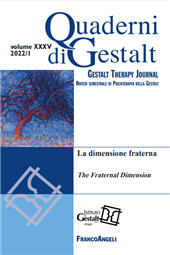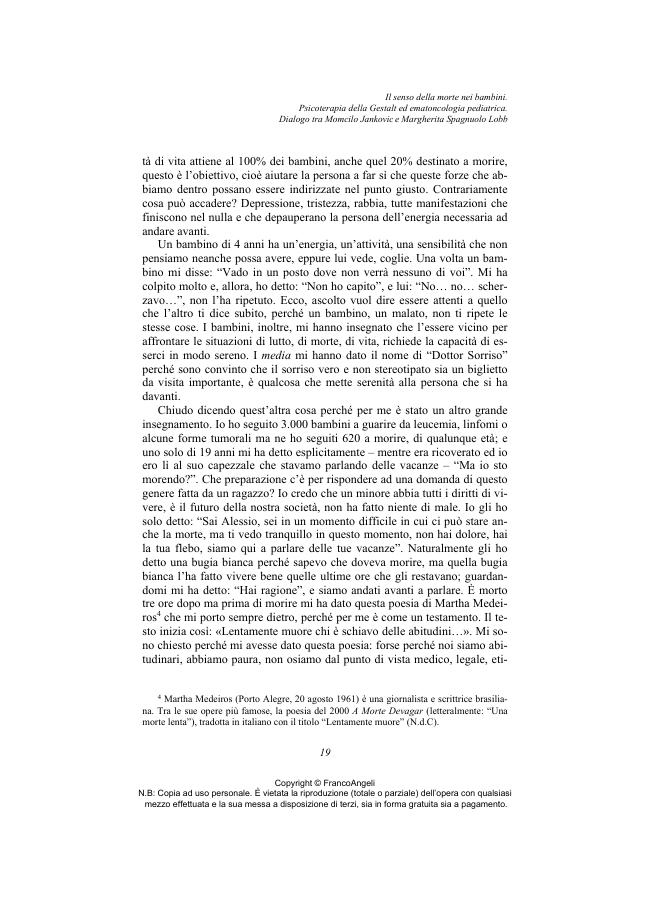Il senso della morte nei bambini : psicoterapia della Gestalt ed ematoncologia pediatrica : dialogo tra Momcilo Jankovice Margherita Spagnuolo Lobb
P. 11-27
L'articolo riporta la trascrizione di un dialogo tra Margherita Spagnuolo Lobb e Momcilo Jankovic sul tema de "Il lutto nei bambini". Nella prima parte, Margherita Spagnuolo Lobb sottolinea come l'intenzionalità di contatto è alla base di ogni relazione per la psicoterapia della Gestalt, che utilizza uno sguardo fenomenologico ed estetico per sostenere nel bambino quello che funziona, che è vitale e ha bisogno di riconoscimento. Le riflessioni di Momcilo Jankovic sottolineano la necessità di integrare sempre di più il mondo medico e quello psicologico. Egli descrive il suo approccio con i bambini malati sottolineando l'importanza di "esserci" per l'altro in maniera sincera e serena, con la capacità di costruire un dialogo basato sul rispetto del bambino e dei suoi tempi di assimilazione della malattia. [Testo dell'editore]
The article reports on the the transcript of a dialogue between Margherita Spagnuolo Lobb and Momcilo Jankovic on the theme of "Mourning in Children". In the first part of the com-parison, Margherita Spagnuolo Lobb emphasizes how the intentionality of contact is the basis of every relationship for Gestalt psychotherapy that uses a phenomenological and aesthetic perspective to sustain what is vital and needs to be recognized in order to effectively work with the child. Margherita Spagnuolo Lobb goes on to describe briefly the theory of "the dance steps" to represent the way in which the mother-child/therapist-patient intentionality is realized. The metaphor of the dance is used to represent the sensations and movements that are activated between the child and his caregiver. This theory includes the concept of interpersonal synchrony, that, as neuroscience demonstrates, is the basis of emotional security, self-regulation and alliance.
Momcilo Jankovic's reflections underline the need to integrate increasingly the medical and psychological worlds. Retracing his forty years of experience in the world of childhood cancer, he defines sick children as "great teachers of life" because they are always committed to living the present, regardless of whether it may be their last days of life. He describes his approach to sick children by emphasizing the importance of "being there for each other in a sincere and serene way, with the ability to build a dialogue based on respect for the child and his time for assimilation of the disease. For Momcilo, the main therapeutic goal is to promote the quality of life in all sick children, even those destined to die. This comparison of the participants shows how important it is for children to be able to express and share the pain for the loss of a loved one, but also to be able to remember the beautiful things done together.
It is also highlighted how the commitment of the "healer" can also be expressed with actions, that is, with doing things with and for the sick child. For Momcilo "doing something together" (sometimes even daring) promotes the alliance with the sick child and, at the same time, helps parents in the process of mourning as it remains the memory of the joy shared with the child. Margherita Spagnuolo Lobb also stresses the importance of introducing/action within the therapeutic setting because it supports the vitality and restructuring of the perceptive and relational gestalt. [Publisher's text]
-
Articles from the same issue (available individually)
-
Information
ISSN: 2035-6994
KEYWORDS
- malattie oncologiche, elaborazione del lutto, bambini, prospettiva relazionale estetica, intenzionalità di contatto
- Oncological diseases, mourning processing, children, Aesthetic Relational Knowledge, intentionality of contact



